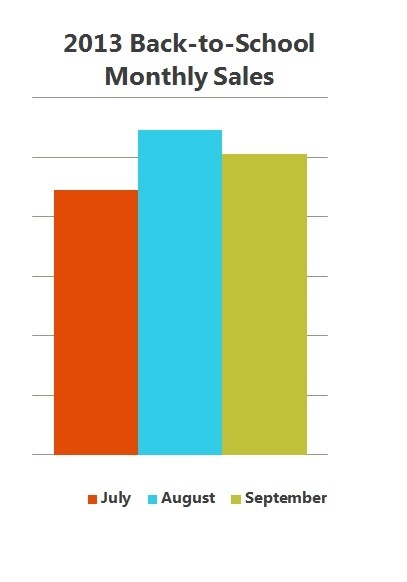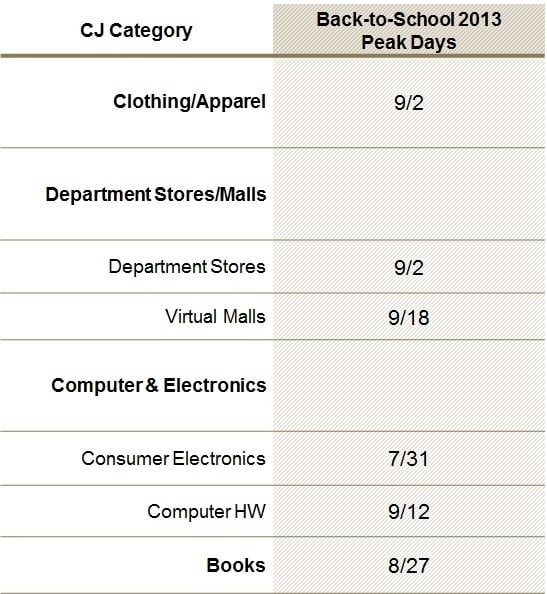This Year's Back-to-School Shopping Trends
Jul 16, 2014
Written by
Sandrine Thompson
As shopping events go, the Back-to-School shopping season is a big deal for retailers—for a third straight year, forecasts show online spending for school supplies outpacing the offline spend, growing 16 percent YoY and reaching $27 billion in online sales. Combined sales for Back-to-School and Back-to-College readiness is estimated to hit $72.5 billion US dollars this year, according to the National Retail Federation.
Back-to-School sales are important for another, less thought-about reason: the uptick in sales that kicks off in mid-July for Back-to-School is effectively a soft launch winter holiday shopping.Shoppers may not be actively shopping for Christmas, but there is a definite quickening of sales activity that starts now and keeps going beyond what could be considered Back-to-School shopping.

August is Key
The Back-to-School shopping season behaves very differently from other important shopping events. The fact that K-12 and college start dates range from late July to mid-September results in a long-stretch of shopping opportunities. Across the CJ categories relevant to school shopping—Children's, Shoes, Office, Malls, Books, Computer HW, Consumer Electronics, Women's and Department Stores—an increase in daily sales begins in mid-July and continues a steady march upward into Labor Day.
But make no mistake—August is crunch time for Back-to-School shopping.
In 2013, the last weeks of August saw particularly strong sales--the peak August shopping day was Wednesday, August 28. The peak shopping days for Back-to-School 2014 will likely be Wednesday, August 27 and Thursday, August 28.
"In many ways, the last weeks of August are equivalent to the weeks before Christmas--shopping audiences are done looking and are primed and waiting for a compelling reason to buy."
Taken in aggregate, the sales for Back-to-School-related categories experienced their greatest gains and greatest sales volume during August. As a marketer, you can benefit by being aware that a large volume of the shoppers who need new shoes, books, clothing or computers are finally inclined to purchase after a stretch of browsing and exploring earlier in the summer. (According to a Google/Ipsos study, 65% of Back-to-School shoppers use July to research and plan purchases, compared to 35 percent who intend to purchase in July.)
The marketing messages sent to shoppers in August should be designed to tap this heightened pressure to purchase and should focus on key value statements that hook the shoppers, such as sales and promotions. In many ways, the last weeks of August are equivalent to the weeks before Christmas—shopping audiences are done looking and are primed and waiting for a compelling reason to buy.
Converting Shoppers
Shoppers this Back-to-School season will likely be seeking a combination of value and convenience.
Value. CJ Network sales for Back-to-School 2013 reflected a growth in average order value in some categories, particularly in the Children's and Mall's categories which grew by 20 percent and six percent, respectively. This signals that shoppers may have felt less pinched in their budgets and ideally, the trend will continue this year. But competition still requires Advertisers to bring some value proposition to the table. Multiple studies of consumers have confirmed that free shipping—whether it be free shipping with no limits or free shipping with a purchase threshold—has the highest opportunity to convert: 80 percent of consumers surveyed are more likely to purchase a product online when offered free shipping1.
Free shipping offers with purchase thresholds are a tried and true way to boost average order values. Shoppers will more often than not toss in extra items to the virtual shopping cart to get what they really care about—free shipping.
Convenience. The demographic which is shopping for Back-to-School supplies is particularly tied to their mobile phones. Namely, busy, on-the-go parents who need to expedite tasks whenever possible, including buying school gear via smartphones and tablets. During Back-to-School 2013, 16 percent of shoppers anticipated they would use their tablet to make a purchase and 13 percent expected to use their smartphone, according to a PriceGrabber.com survey.
Advertisers and Publishers can tap this on-the-go buyer by creating a mobile experience that fulfills on the need for convenience…and speed. Smooth mobile experiences can be many things—easy to find shopping guides, prominent displays of offers, and (ideally) a mobile responsive website.
Labor Day—Q3's Black Friday
Advertisers in the Children's, Malls, Department Stores, Women's and Shoes categories last year got an additional peak on Labor Day 2013. The popular thinking that Labor Day is a shopping holiday important only for Outdoor and Home & Garden Advertisers doesn't hold up in the affiliate channel. Indeed, retailers across all categories should view Labor Day as the Black Friday of Q3, where being present with offers and email engagement is a key marketing goal.
Last year, sales on Labor Day in Back-to-School categories increased 24 percent over the average daily sales of the prior week. Labor Day this year is Monday, September 1.
Key Dates for Key Categories

1. [Walker Sands", 2014 Future of Retail Study] Back to Text
Expand Your Brand’s Reach
Achieve sustained growth and reach your target audience. Work with world-class publishers and influencers to successfully promote brand products and services.
Partner with the World’s Best Brands
Earn seamlessly by partnering with the world’s most widely recognized brands, promoting products and services your audience enjoys. Engage with brands you know and love all in one place.
Share